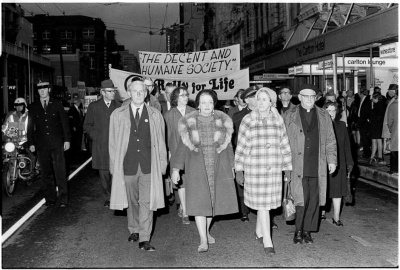Articles
The 1912 Waihi strike

On 'Black Tuesday', 12 November 1912, in the midst of a bitter six-month strike by miners in the small New Zealand goldmining town of Waihi, striker Fred Evans was killed - one of only two fatalities in an industrial dispute in New Zealand's history.
- Page 1 - 'Black Tuesday'On 'Black Tuesday', 12 November 1912, in the midst of a bitter six-month strike by miners in the small New Zealand goldmining town of Waihi, striker Fred Evans was killed - one of
1981 Springbok tour

For 56 days in July, August and September 1981, New Zealanders were divided against each other in the largest civil disturbance seen since the 1951 waterfront dispute. The cause of this was the visit of the South African rugby team – the Springboks.
-
Page 4 – Stopping the 1973 tour
Keeping sport and politics separate was becoming increasingly difficult. In July 1969 HART (Halt All Racist Tours) was founded by University of Auckland students with the
-
Page 6 – Battle lines are drawn
The tour supporters were determined that the first Springbok visit to New Zealand since 1965 would not be spoiled. The anti-tour movement was equally determined to show its
-
Page 7 – Tour diary
Select itinerary of the 1981 tour by the Springbok rugby team.
-
Page 8 – Impact
In Hamilton the protestors occupying the pitch had chanted 'The whole world is watching'. The same applied to New Zealand as a nation. Some believed the tour was an opportunity
The 1951 waterfront dispute

The 1951 waterfront dispute was the biggest industrial confrontation in New Zealand’s history. Although it was not as violent as the Great Strike of 1913, it lasted longer – 151 days, from February to July – and involved more workers.
-
Page 2 – Countdown to confrontation
New Zealanders generally accepted the hardships and restrictions of the war years as necessary in the fight against fascism. After the war, though, many began to demand a
-
Page 3 – War on the wharves
With New Zealand’s vital export trade at stake when the wharves came to a standstill, the government declared a state of emergency on 21 February.
-
Page 4 – Division and defeat
The watersiders’ militancy had isolated them from most unionists and Walter Nash’s Labour Party Opposition sat uncomfortably on the fence, denouncing government
The 1913 Great Strike

The Great Strike of 1913 was in fact a series of strikes between mid-October 1913 and mid-January 1914. It was one of New Zealand’s most violent and disruptive industrial confrontations.
-
Page 4 – The 1913 strike in Wellington
Because the strike threatened their livelihoods, rural men were keen to volunteer as special constables.
-
Page 5 – The 1913 strike in Auckland
Watersiders in Auckland began to strike in support of those in Huntly and Wellington.
-
Page 6 – The 1913 strike in the South Island
Although the 1913 strike had its biggest impact on Auckland and Wellington, the South Island's cities and mining towns were also affected.
Related keywords
- 1913 strike
- dunedin
- greymouth
- buller
- runanga
- brunner
- blackball
- lyttelton
- trade unions
- protest
- coal mining
- workers rights
- denniston
- maps
- auckland city
- red feds
- wellington city
- 1970s
- labour party
- strikes
- sidney holland
- national party
- fintan patrick walsh
- waterfront dispute
- police
- waihi
- war objects
- jayforce
- cold war
- fred evans
- rugby
- sport
- springboks
- south africa
- robert muldoon
- apartheid
- 1980s
- norman kirk
- HART
- all blacks
-
Main image: Anti-abortion march in Wellington
Anti abortion demonstrators marching in Willis Street, Wellington, 1974





